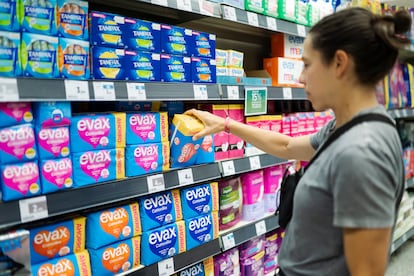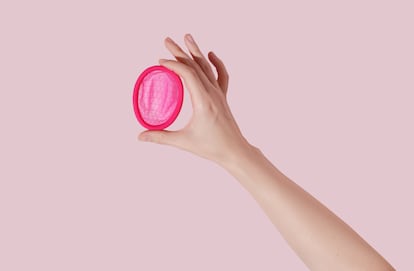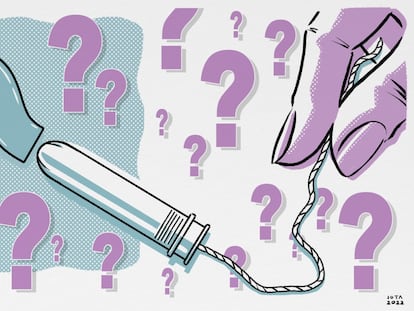Study claims no real blood is used to test menstruation products
Researchers point out that only saline solutions are used, distorting manufacturers claims and complicating diagnoses of menorrhagia

A woman’s menstrual blood has not only been represented with blue liquids in screen ads, the “blood” used in scientific studies has also been fake. Until now, most studies opted for water or saline solutions to analyze the absorption capacity of the various feminine hygiene products, a standard that was established in 1982 by The Tampon Task Force, and which most companies have followed since.
This is the claim made by a study carried out at the Oregon Health and Science University in the U.S., which maintains it is the first to be using human blood during testing. Its results have just been published in the scientific journal BMJ Sexual & Reproductive Health and conclude that menstrual pads retain the greatest amount of menstrual flow.
The menstrual disc is a new take on the menstrual cup. Instead of being concave, it is smooth with a double rim that prevents leakage. It is placed under the cervix, and so remains in place during sexual intercourse. Like the cup, it is reusable, limiting its cost and environmental impact. Despite these advantages, it is less popular than the cup and much less popular than tampons and pads, with which it was compared during the analysis. However, the Oregon study could help to boost the popularity of these discs, as it points out that it is the most suitable device for people with heavy periods, a condition known as menorrhagia, experienced by one in three women.
The study also finds the absorbent capacity with which these products are advertised is at odds with reality. “Most claimed a higher capacity than was apparent from our tests,” says Bethany Samuelson, Ph.D., the study’s main author. This could be due to the way the tests were performed. “Physiological saline or water has a different viscosity from blood compounds,” she says. “But what’s more, there is no industry regulation that requires testing the capacity [of these products] except in the case of tampons, which is due to the link to toxic shock syndrome,” she adds. At the time this article was published, Procter Gamble España, the company that controls commercial brands such as Evax, Tampax and Ausonia, had not replied to El PAÍS’s request for information on the issue.

The scientific distortion of the actual absorption of these products can have medical implications, says Samuelson: “Diagnoses of heavy menstrual bleeding can go unnoticed because doctors don’t know how much blood is contained in the various menstrual products,” she explains. Typically, during a normal period, 70 to 80 milliliters of fluid — about a quarter cup — is lost. But people with heavy menstrual bleeding can lose anywhere from 160 to 400 milliliters. Many women with menorrhagia are not aware they have it, since it is not a widely known condition.
Understanding the actual effectiveness of tampons, pads, and cups could help to objectively measure menstruation and detect when bleeding is heavier than normal, according to the study, which did not use actual menstrual blood, but instead a compound made from human blood tested in the laboratory. These are limitations that Samuelson acknowledges: “Our study was the best approximation we could get, but it definitely has limitations,” she says. Still, she believes the conclusions are closer to reality than studies using blood substitutes.
Taboos
Despite the fact that 800 million people in the world have periods, menstruation remains taboo because it lies at an intersection between sex, blood and everything that is exclusively female. “It is a completely normal bodily function that affects half the population for an average of 40 years of their lives,” Samuelson says. “The taboos, stigma and shame surrounding menstruation are deeply damaging.”
The taboos impact scientific research by creating a knowledge gap around this natural bodily function — a gap probed by Stanford University in a recent study that quantified the underrepresentation of this topic in scientific literature. A search for “menstrual blood” in the PubMed medical database yielded only 400 results from studies conducted in the last few decades, while erectile dysfunction yielded about 10,000 results over the same period. “Research on women’s health in general and menstruation in particular remains underrepresented in medical literature,” the Stanford University study concluded.
“Having data on the absorption capacity of modern products is important,” says Samuelson, referring to her team’s research. “This is especially so when we take into account the financial burden of buying not only these products, but also the painkillers and other associated expenses.” Some people cannot afford these outlays, and fall into so-called menstrual poverty.
Between the first menstruation and menopause, it is estimated that a woman will have around 400 periods. It is a routine event for half of the population, and yet it is still shrouded in a great deal of ignorance. “There is a lack of good data and a lack of funding,” Samuelson says, adding that there is also a lack of openness on the subject. “Every week I see patients who have had heavy periods for decades but didn’t know it was abnormal because they hadn’t been properly educated about what is and isn’t normal and didn’t feel comfortable talking about their periods with other people,” she says. “We have to change that.”
Sign up for our weekly newsletter to get more English-language news coverage from EL PAÍS USA Edition
Tu suscripción se está usando en otro dispositivo
¿Quieres añadir otro usuario a tu suscripción?
Si continúas leyendo en este dispositivo, no se podrá leer en el otro.
FlechaTu suscripción se está usando en otro dispositivo y solo puedes acceder a EL PAÍS desde un dispositivo a la vez.
Si quieres compartir tu cuenta, cambia tu suscripción a la modalidad Premium, así podrás añadir otro usuario. Cada uno accederá con su propia cuenta de email, lo que os permitirá personalizar vuestra experiencia en EL PAÍS.
¿Tienes una suscripción de empresa? Accede aquí para contratar más cuentas.
En el caso de no saber quién está usando tu cuenta, te recomendamos cambiar tu contraseña aquí.
Si decides continuar compartiendo tu cuenta, este mensaje se mostrará en tu dispositivo y en el de la otra persona que está usando tu cuenta de forma indefinida, afectando a tu experiencia de lectura. Puedes consultar aquí los términos y condiciones de la suscripción digital.
More information
Últimas noticias
The new victims of the Republican war on Obamacare: Millions hit by soaring health insurance premiums
A country divided on migrant rights: Some US states expand protections while others restrict them
Venezuela authorizes the release of another 87 political prisoners
There is as much life left to discover on planet Earth as that which is already known
Most viewed
- David King, chemist: ‘There are scientists studying how to cool the planet; nobody should stop these experiments from happening’
- Reinhard Genzel, Nobel laureate in physics: ‘One-minute videos will never give you the truth’
- Oona Chaplin: ‘I told James Cameron that I was living in a treehouse and starting a permaculture project with a friend’
- Sinaloa Cartel war is taking its toll on Los Chapitos
- The Interoceanic Train, the Mexican alternative to the Panama Canal











































